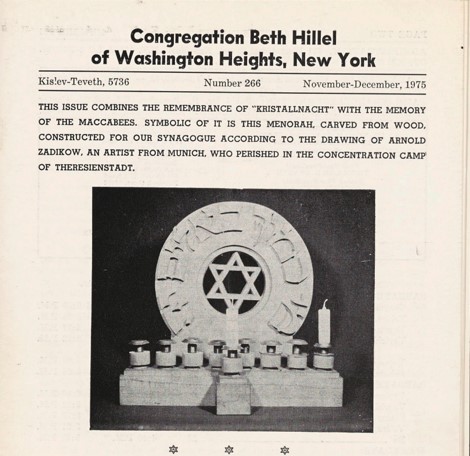The survival of the menorah in the Temple in the Hanukkah story is generally taken for granted, while the miracle of the lone cruse of pure, undefiled oil, is well known. The oil was only sufficient to light the menorah for one day, yet it kept the menorah alight for eight days, enough time for the Maccabees to prepare pure new oil. Yet the survival of the menorah itself is a miracle; although it was gold it could have been melted or looted by the Seleucid invaders.
A menorah housed in a modest synagogue in Washington Heights for half a century was also a survivor, a symbol of the flame of Judaism which was not extinguished, even during the dark days of the Holocaust.

Arnold Zadikow was a well-known German Jewish sculptor, artist, and architect. His sculpture of King David as a young man graced the entrance of the Berlin Jewish Museum when it opened in 1933; Zadikow stated that the muscular David was his answer to Hitler and the Nazis.
Zadikow was deported to Theresienstadt in 1942. He designed this menorah in Theresienstadt and Leopold Hecht, a master wood carver, covertly obtained the wood and executed Zadikow’s design. The menorah was hidden during the year but was surreptitiously used in an underground room on Hanukkah. One of its purposes was to teach the children in the camp about Hanukkah.
Zadikow died in Theresienstadt in 1943 of a ruptured appendix. His wooden menorah survived the flames of the war. It was recovered at Theresienstadt. Zadikow’s wife Hilda and daughter Marianka survived Theresienstadt and Auschwitz and repatriated the menorah.
The menorah took pride of place in Congregation Beth Hillel from 1950 until about 2000. Beth Hillel was a German congregation founded in Washington Heights in 1939. The congregation was very proud of its German heritage; some of the congregational bulletins located in the Yeshiva University Archives include content in German as late as 1985. The cherished Zadikow menorah was featured in several of the synagogue’s bulletins over the years; the issue of December 1988 reiterated the importance of this historic ceremonial object, which served a living Jewish religion and community: “in reverent salute to the memories it evokes, we kindle each year’s first Chanukkah light on this Menorah.”
Beth Hillel’s population base dwindled and it lives on through its merger with Mount Sinai Jewish Center in 2001. An internet search reveals that the Zadikow menorah is currently in the collections of the Jewish Museum. This menorah, a brand plucked from the fire, once hidden underground, is now lovingly and carefully tended and guarded, a symbol of eternal Jewish life and light.
Shulamith Z. Berger

